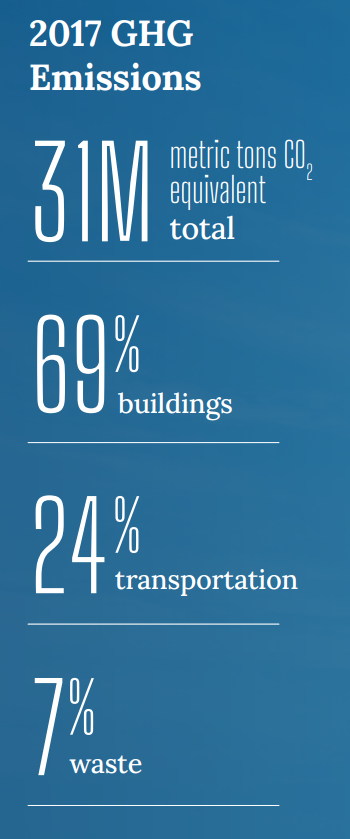Electrify Chicago
An independent tool for viewing City of Chicago building data
According to the
2022 Chicago Climate Action Plan,
69% of Chicago's emissions come from buildings, making
building emissions our biggest challenge and our biggest opportunity as a city
to tackle climate change. At Electrify Chicago, we showcase building performance using
publicly available data supplemented by community-submitted photographs and building
owners.
Start by looking at Chicago's buildings with the highest greenhouse gas intensity i.e. emissions per square foot. Large, efficient, buildings can perform much better than very inefficient small buildings on this metric.
New Article
📰 $30 Million In Missed Fines
The City Of Chicago failed to collect $30 million in potential fines from the building benchmarking ordinance, reducing transparency and accountability.
Legislative update! 🎉
As of late January 2024, legislation is being introduced to require new use more efficient forms of water and space heating, via the Clean And Affordable Buildings Ordinance (CABO), which will reduce the number of highly polluting and inefficient buildings that end up on this site.
If you're in Chicago,
write to your alderman to support the CABO!
Chicago Buildings by Greenhouse Gas Intensity
Note: Data includes large Chicago buildings with data from 2022, unless explicitly stated otherwise.
Note: This data only includes buildings whose emissions are reported
under the
Chicago Energy Benchmarking Ordinance. According to the City “As of 2016,
this list includes all commercial, institutional, and residential buildings larger than
50,000 square feet.” This dataset is also then filtered to only buildings with
reported emissions > 1,000 metric tons CO2 equivalent.
The latest year of data is from 2022, but we update the site regularly when new data is available, and some buildings may have failed to report that year, and only have older data available.
| Property Name / address | Primary Property Type |
Greenhouse Gas Intensity (kg CO2 eq./sqft) |
Total Greenhouse Emissions (metric tons CO2 eq.) |
|---|---|---|---|
|
3594
🕰️
5050 S Kedzie Ave
| Retail Store | 12.2 kg/sqft | 1,452 tons |
|
Ascension St Elizabeth Professional Office Building
🕰️
1431 N Western Ave
| Medical Office | 12.1 kg/sqft | 860 tons |
|
The Private Residences at Ontario Place Condominiu
10 E Ontario St
| Multifamily Housing | 12.1 kg/sqft
Highest 8%
| 5,918 tons
Highest 5%
|
|
WTTW 11 - Main Campus
5400 N St Louis Ave
| Office | 12.1 kg/sqft
Highest 8%
| 2,206 tons
Highest 20%
|
|
The Clare
🚩
55 E Pearson St
| Multifamily Housing | 12.1 kg/sqft
Highest 8%
| 7,570 tons
Highest 4%
|
|
Aurora Chicago Lakeshore Hospital
🕰️
4840 N. Marine Drive
| Other - Specialty Hospital | 12.1 kg/sqft | 619 tons |
|
Villa at Windsor Park
2649 E 75th St
| Senior Living Community | 12.1 kg/sqft
Highest 8%
| 1,183 tons
Highest 39%
|
|
Sherman Plaza
🕰️
161-205 W. 87th Street
| Other - Mall | 12.1 kg/sqft | 734 tons |
|
Block 37
🕰️
108 N. State Street
| Multifamily Housing | 12.1 kg/sqft | 12,294 tons |
|
Marquette Building
🕰️
140 South Dearborn Street
| Office | 12.1 kg/sqft | 4,492 tons |
|
Ace Hotel Chicago
🕰️
311 N MORGAN ST
| Hotel | 12.0 kg/sqft | 1,541 tons |
|
Gilman Smith
🕰️
5835 S Drexel Ave
| Laboratory | 12.0 kg/sqft | 2,694 tons |
|
NortHigh School ide College Prep HS -CPS
(CPS)
5501 N Kedzie Ave
| K-12 School | 12.0 kg/sqft
Highest 8%
| 2,673 tons
Highest 16%
|
|
4640 S Halsted St
4640 S Halsted St
| Supermarket/Grocery Store | 12.0 kg/sqft
Highest 8%
| 1,753 tons
Highest 27%
|
|
Union League Club Of Chicago
🕰️
65 W Jackson Blvd
| Hotel | 12.0 kg/sqft | 3,728 tons |
Data Source:
Chicago Energy Benchmarking Data
